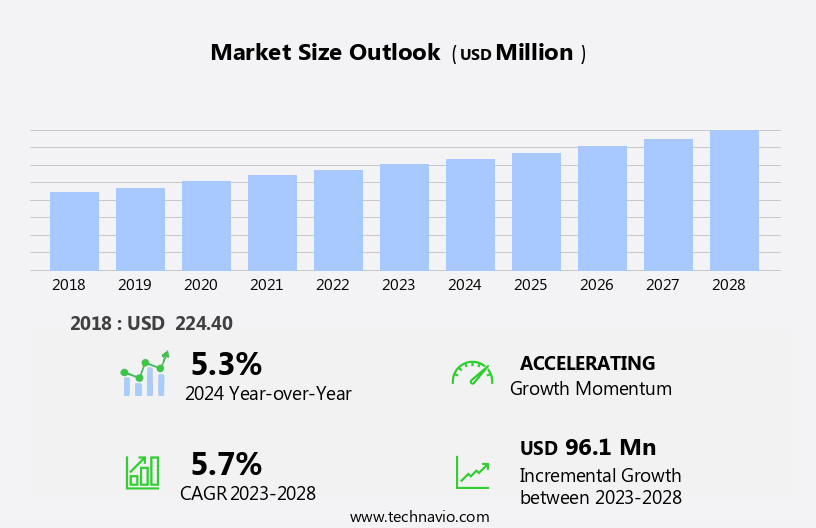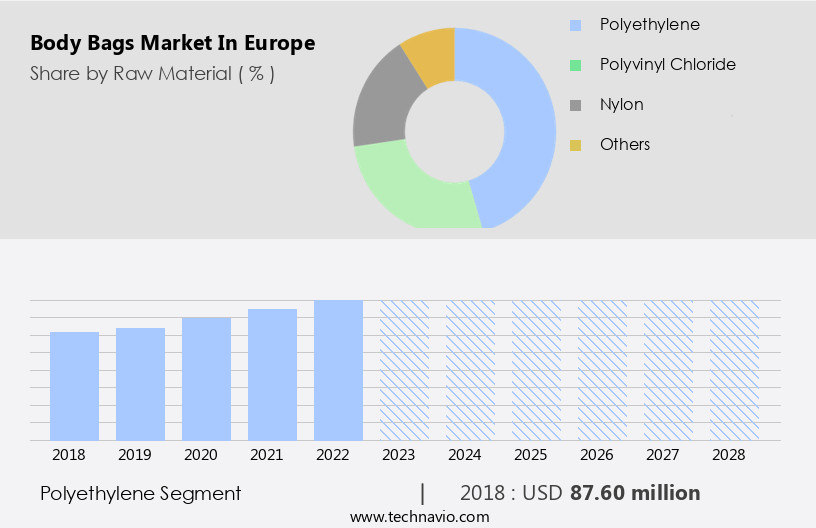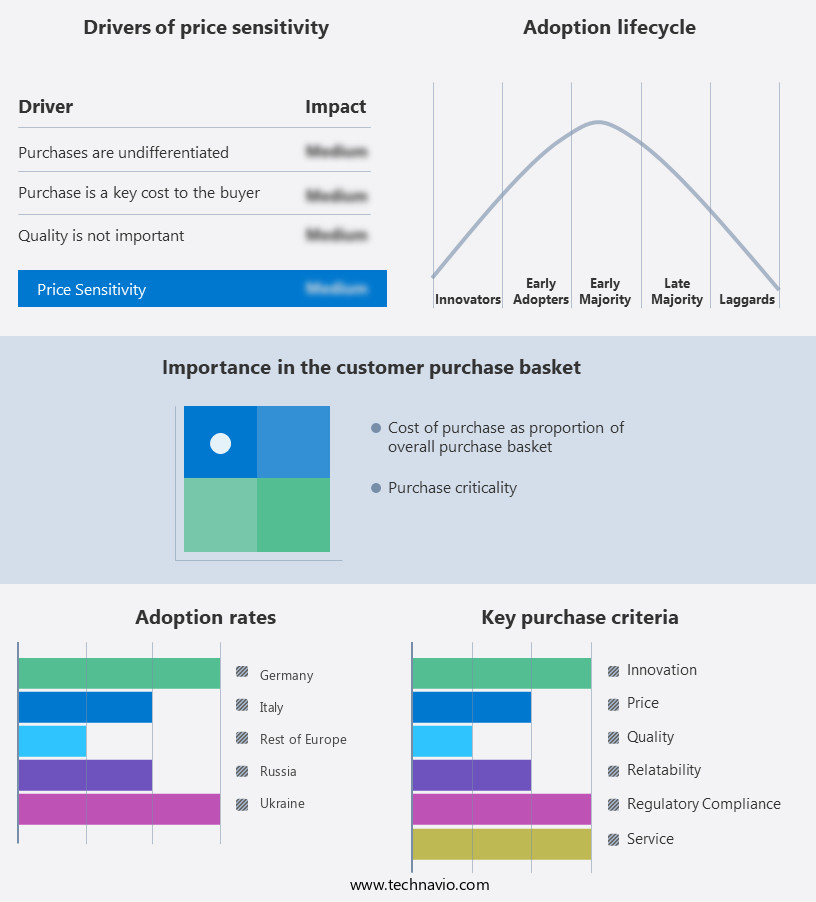Europe Body Bags Market Size 2024-2028
The Europe body bags market size is forecast to increase by USD 96.1 million, at a CAGR of 5.7% between 2023 and 2028.
- The European body bags market is driven by the increasing prevalence of chronic diseases and the subsequent rise in mortality rates. This trend underscores the growing demand for efficient and hygienic body storage solutions, particularly in healthcare facilities and mortuaries. Furthermore, the increasing number of traffic accidents, a common cause of sudden, unexpected deaths, adds to the market's growth. However, the market faces challenges in the form of environmental concerns. Traditional body bags, often made of plastic, contribute significantly to landfill waste and environmental pollution. Consequently, there is a growing demand for eco-friendly alternatives, such as biodegradable body bags made from natural materials.
- Companies seeking to capitalize on market opportunities should focus on developing sustainable, cost-effective, and efficient body bag solutions to cater to the evolving needs of the European market. Additionally, they should prioritize regulatory compliance and adhere to stringent quality standards to maintain their market position and build customer trust.
What will be the size of the Europe Body Bags Market during the forecast period?

Explore in-depth regional segment analysis with market size data - historical 2018-2022 and forecasts 2024-2028 - in the full report.
Request Free Sample
- The European body bags market experiences dynamic activity driven by stringent customer requirements for infection control and waste reduction. Quality assurance is paramount, with oxygen barrier films and moisture resistance essential for preserving the integrity of the contained remains. Product certifications, such as those related to logistic efficiency and supply chain management, are increasingly sought after. Polypropylene fabric and polyvinyl chloride are popular materials due to their durability and thermal bonding capabilities. Label adhesion and zipper durability are crucial for efficient handling and transportation. In response to environmental regulations, recycling processes and composting rates are gaining importance.
- Microbial barrier films and RFID readability enhance infection control and streamline tracking. Production efficiency is a key focus, with seam strength and biodegradation testing ensuring high-quality products. Material sourcing and storage capacity are also vital considerations for market players. Market trends include the integration of advanced technologies, such as thermal bonding and RFID tags, to improve efficiency and meet evolving customer demands. Ongoing research into biodegradable materials and composting processes further underscores the industry's commitment to sustainability.
How is this market segmented?
The market research report provides comprehensive data (region-wise segment analysis), with forecasts and estimates in "USD million" for the period 2024-2028, as well as historical data from 2018-2022 for the following segments.
- Raw Material
- Polyethylene
- Polyvinyl chloride
- Nylon
- Others
- End-user
- Geography
- Europe
- Germany
- Italy
- Russia
- Ukraine
By Raw Material Insights
The polyethylene segment is estimated to witness significant growth during the forecast period.
Body bags, made primarily from polyethylene, are a vital solution for transporting and disposing of bodies with non-communicable diseases in Europe. The use of polyethylene, a durable, lightweight, and cost-effective plastic, ensures leak-proof protection. This material offers additional benefits, including adaptability, rigidity, and ease of recycling, making it a preferred choice for body bag manufacturers. Safety is a top priority in the production and disposal of body bags. companies employ safe disposal methods and sanitary regulations to ensure proper handling. The bags are designed with leakproof seams, body bag handles, and identification labels for easy tracking and traceability.
RFID tagging systems and quality control systems are integrated to maintain regulatory compliance and biohazard containment. Manufacturing processes adhere to ethical sourcing and sustainable practices, minimizing the environmental impact. Biodegradable polymers and recyclable materials are increasingly used to reduce waste and promote waste management practices. Cremation compatibility and burial suitability are also essential considerations. Pathogen transmission is mitigated through sterilization methods, such as autoclaving and gamma irradiation. UV resistance fabrics and material durability ensure the bags maintain their integrity during storage and transportation. The body bags' lifespan is influenced by various factors, including handling procedures, storage solutions, and sealing technologies.
In conclusion, the market is driven by the adoption of polyethylene due to its advantages in durability, recyclability, and leak-proof properties. Companies prioritize safety, sanitation, and regulatory compliance while continually innovating to minimize environmental impact and improve the overall user experience.

Download Free Sample Report
The Polyethylene segment was valued at USD 87.60 million in 2018 and showed a gradual increase during the forecast period.
Market Dynamics
Our researchers analyzed the data with 2023 as the base year, along with the key drivers, trends, and challenges. A holistic analysis of drivers will help companies refine their marketing strategies to gain a competitive advantage.
What are the Europe Body Bags Market drivers leading to the rise in adoption of the Industry?
- The escalating incidence of chronic diseases serves as the primary catalyst for market growth.
- In Europe, chronic diseases such as cancer, cardiovascular diseases (CVD), chronic obstructive pulmonary disease (COPD), diabetes, and viral diseases continue to rise due to various lifestyle-related factors. These factors include smoking, drinking, exposure to biomass fuels, disrupted lifestyle patterns, and air pollution. CVD is a significant concern, as it remains the leading cause of death in Europe. Each year, CVD claims over 3.9 million lives in Europe and over 1.8 million lives in the EU. To address the increasing need for safe and efficient handling of deceased individuals, the European market for body bags has gained traction. Body bags with water-resistant coatings and leakproof seams ensure safe disposal methods and preserve decomposition rates.
- Compliance with sanitary regulations is crucial, and handling procedures must adhere to these standards. Transport containers for body bags should be designed with recyclable materials and be easily transported. Body bag handles must be strong and secure to facilitate easy handling. The market prioritizes the use of materials that meet health and safety requirements and are environmentally friendly. The European body bag market is committed to continuous improvement and innovation, focusing on the development of new materials and technologies that enhance the functionality and sustainability of body bags. This includes the use of biodegradable materials and advanced waterproof coatings with longer durability.
What are the Europe Body Bags Market trends shaping the Industry?
- The increasing prevalence of traffic accidents represents a significant market trend. This trend underscores the growing demand for advanced safety technologies and solutions in the transportation industry.
- The European body bags market is driven by the need for effective product traceability and stringent quality control systems in the healthcare industry. RFID tagging systems are increasingly being adopted to ensure accurate tracking of body bags throughout the supply chain. Pathogen transmission and the importance of maintaining sterile conditions during storage and transportation have led to the implementation of advanced sterilization methods and robust zipper mechanisms. Manufacturing processes are being optimized to minimize the environmental impact, with a focus on sustainable materials and energy-efficient solutions. As the demand for body bags continues to grow, innovative storage solutions are being developed to accommodate the increasing number of units required.
- The use of RFID tagging and advanced manufacturing processes also contributes to the overall efficiency and reliability of the market. Quality control systems are a critical aspect of the body bags market, with strict regulations in place to ensure the highest standards of hygiene and safety. This includes the implementation of rigorous testing procedures and the use of certified materials to prevent any potential contamination or transmission of pathogens. Sterilization methods, such as autoclaving and gamma irradiation, are essential to maintaining the integrity and safety of body bags. These methods ensure that the bags are free from any harmful bacteria or viruses, providing peace of mind for healthcare professionals and patients alike.
- In conclusion, the European body bags market is characterized by a focus on product traceability, quality control, and sustainability. RFID tagging systems, advanced manufacturing processes, and stringent regulations are driving innovation and growth in the market, ensuring that body bags meet the highest standards of hygiene, safety, and efficiency.
How does Europe Body Bags Market faces challenges face during its growth?
- The growth of the industry is significantly influenced by the environmental implications of using body bags, which poses a significant challenge that necessitates continuous research and implementation of eco-friendly solutions.
- Body bags in Europe are manufactured using various materials, including olefins, polypropylene, reinforced poly material, PVC, nylon, mesh PVC, and bioplastics such as polylactic acid (PLA) and polyhydroxyalkanoates (PHA). While some materials, like PLA and PHA, are biodegradable and better for the environment, others, such as nylon, are non-biodegradable and remain in the environment indefinitely. Recycling body bags is a significant challenge, and the increasing production of plastic body bags due to the high mortality rate associated with COVID-19 has had a detrimental effect on the environment. The manufacturing process of plastic body bags involves the emission of toxic chemicals, leading to pollution of land, water, and air.
- To address these concerns, companies are developing more sustainable solutions for body bags, such as those made from biodegradable polymers. Regulatory compliance with waste management practices and cremation compatibility are crucial factors driving the market's evolution. Sealing technologies also play a vital role in maintaining the integrity of the body bag during transportation and storage. Overall, the European body bags market is undergoing a shift towards more environmentally friendly and sustainable practices.
Exclusive Europe Body Bags Market Customer Landscape
The market forecasting report includes the adoption lifecycle of the market, covering from the innovator's stage to the laggard's stage. It focuses on adoption rates in different regions based on penetration. Furthermore, the report also includes key purchase criteria and drivers of price sensitivity to help companies evaluate and develop their market growth analysis strategies.

Customer Landscape
Key Companies & Market Insights
Companies are implementing various strategies, such as strategic alliances, market forecast partnerships, mergers and acquisitions, geographical expansion, and product/service launches, to enhance their presence in the market.
The market research and growth report includes detailed analyses of the competitive landscape of the market and information about key companies, including:
- 3D Barrier Bags Inc.
- Auden Funeral Supplies Ltd.
- Boen Healthcare Co. Ltd.
- Cold GmbH
- Devon Disability Collective
- EIHF ISOFROID
- EMS Mobil Sistemler A.S.
- HYGECO International SA
- Jiangsu Rooe Medical
- LDI Solutions LLC
- Mortech Manufacturing
- MP Acquisition LLC
- MuHeSa Verpackungsmittel
- Neogen Corp.
- Roftek Ltd.
- Slik Pak Ltd.
- Synrein Medical
- The Embalmers Supply Co.
- Vezzani spa
- Wye Valley Manufacturing
Qualitative and quantitative analysis of companies has been conducted to help clients understand the wider business environment as well as the strengths and weaknesses of key market players. Data is qualitatively analyzed to categorize companies as pure play, category-focused, industry-focused, and diversified; it is quantitatively analyzed to categorize companies as dominant, leading, strong, tentative, and weak.
Recent Development and News in Body Bags Market In Europe
- In January 2024, Medline Industries, a leading global manufacturer and distributor of medical supplies, announced the launch of its new range of sustainable body bags, made from recycled materials, in the European market (Medline Industries Press Release, 2024). This move marked a significant shift towards eco-friendly products in the body bags market.
- In March 2024, German medical equipment manufacturer, Getinge, entered into a strategic partnership with Dutch biotech firm, Uniqura, to develop advanced sterilization solutions for body bags (Getinge Press Release, 2024). This collaboration aimed to enhance the hygiene standards in the European healthcare sector.
- In May 2024, the European Commission approved the acquisition of Smiths Medical by the American multinational corporation, Wolters Kluwer, for approximately ⬠11.5 billion (European Commission Press Release, 2024). The acquisition included Smiths Medical's medical devices business, which included its body bags product line.
- In February 2025, the UK-based company, Drax Biomass, announced the successful completion of its biomass pellet production plant in Romania, which would supply raw materials for the production of body bags made from sustainable sources (Drax Biomass Press Release, 2025). This development represented a key geographic expansion and a significant step towards increasing the use of renewable resources in body bag manufacturing.
Research Analyst Overview
The market continues to evolve, with dynamic market activities unfolding across various sectors. Product offerings in this market are characterized by advanced features designed to ensure effective containment and safe disposal of human remains. Water-resistant coatings and leakproof seams are integral components of body bags, ensuring the preservation of dignity and maintaining hygiene standards. RFID tagging systems and product traceability mechanisms facilitate efficient tracking and management of inventory. Quality control systems and stringent sanitary regulations are paramount to prevent pathogen transmission and ensure the highest standards of hygiene. Sterilization methods, including UV resistance fabrics, are employed to minimize the risk of contamination and maintain the integrity of the bags.
Zipper mechanisms and storage solutions are engineered for ease of use and durability, while manufacturing processes adhere to sustainable practices and ethical sourcing standards. Cremation compatibility and biodegradable polymers are emerging trends, as the market shifts towards more eco-friendly solutions. Waste management practices and recyclable materials are also gaining traction, reflecting the industry's commitment to minimizing environmental impact. Body bag disposal and suitability for burial are critical considerations, with a focus on sustainable practices and regulatory compliance. Sealing technologies and identification labels ensure biohazard containment and enable efficient handling procedures during transport and storage. The evolving market dynamics underscore the importance of ongoing innovation and adaptation to meet the diverse needs of customers and stakeholders.
Dive into Technavio's robust research methodology, blending expert interviews, extensive data synthesis, and validated models for unparalleled Body Bags Market in Europe insights. See full methodology.
|
Market Scope
|
|
Report Coverage
|
Details
|
|
Page number
|
147
|
|
Base year
|
2023
|
|
Historic period
|
2018-2022 |
|
Forecast period
|
2024-2028
|
|
Growth momentum & CAGR
|
Accelerate at a CAGR of 5.7%
|
|
Market growth 2024-2028
|
USD 96.1 million
|
|
Market structure
|
Fragmented
|
|
YoY growth 2023-2024(%)
|
5.3
|
|
Competitive landscape
|
Leading Companies, Market Positioning of Companies, Competitive Strategies, and Industry Risks
|
Request Free Sample
What are the Key Data Covered in this Market Research Report?
- CAGR of the market during the forecast period
- Detailed information on factors that will drive the market growth and forecasting between 2024 and 2028
- Precise estimation of the size of the market and its contribution of the market in focus to the parent market
- Accurate predictions about upcoming market growth and trends and changes in consumer behaviour
- Growth of the market across Europe
- Thorough analysis of the market's competitive landscape and detailed information about companies
- Comprehensive analysis of factors that will challenge the growth of market companies
We can help! Our analysts can customize this market research report to meet your requirements Get in touch







![]() Get the report (PDF) sent to your email within minutes.
Get the report (PDF) sent to your email within minutes.
Complimentary full Excel data with your report purchase.